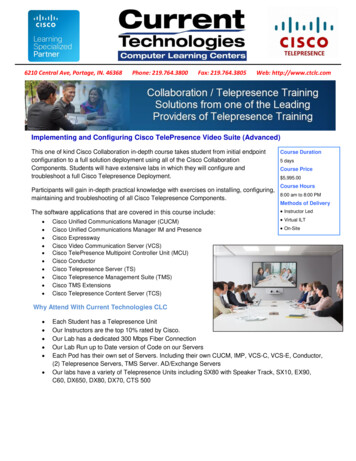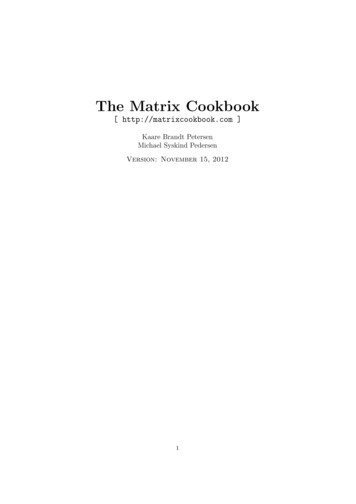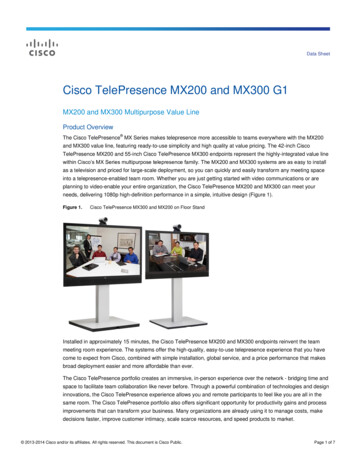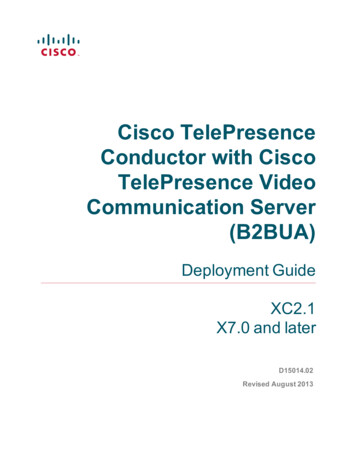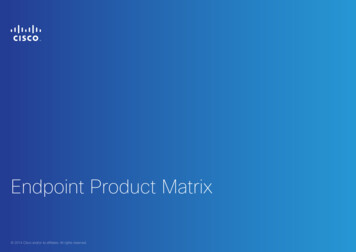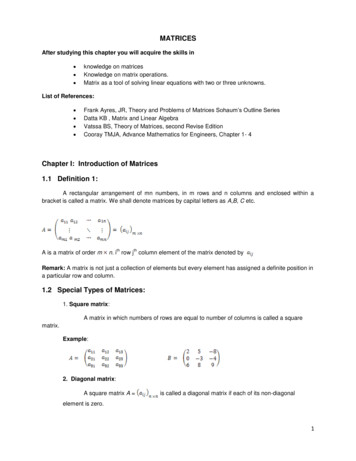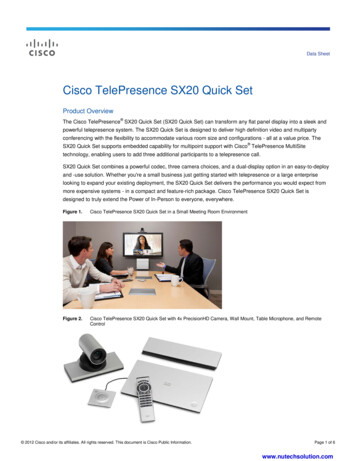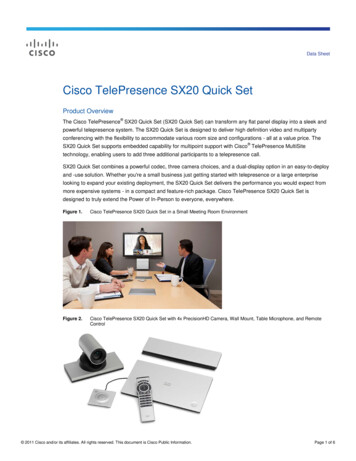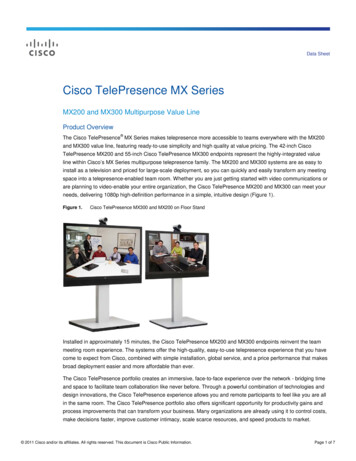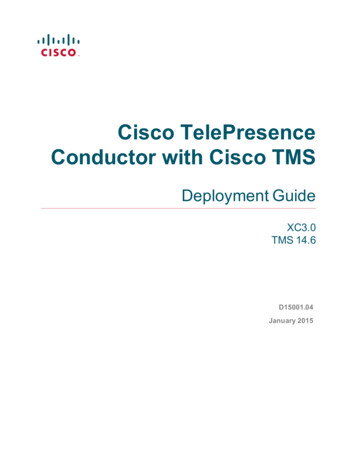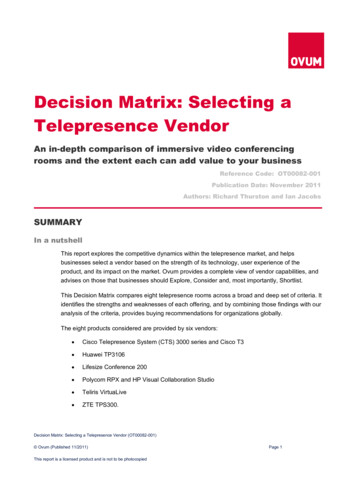
Transcription
Decision Matrix: Selecting aTelepresence VendorAn in-depth comparison of immersive video conferencingrooms and the extent each can add value to your businessReference Code: OT00082-001Publication Date: November 2011Authors: Richard Thurston and Ian JacobsSUMMARYIn a nutshellThis report explores the competitive dynamics within the telepresence market, and helpsbusinesses select a vendor based on the strength of its technology, user experience of theproduct, and its impact on the market. Ovum provides a complete view of vendor capabilities, andadvises on those that businesses should Explore, Consider and, most importantly, Shortlist.This Decision Matrix compares eight telepresence rooms across a broad and deep set of criteria. Itidentifies the strengths and weaknesses of each offering, and by combining those findings with ouranalysis of the criteria, provides buying recommendations for organizations globally.The eight products considered are provided by six vendors: Cisco Telepresence System (CTS) 3000 series and Cisco T3 Huawei TP3106 Lifesize Conference 200 Polycom RPX and HP Visual Collaboration Studio Teliris VirtuaLive ZTE TPS300.Decision Matrix: Selecting a Telepresence Vendor (OT00082-001) Ovum (Published 11/2011)This report is a licensed product and is not to be photocopiedPage 1
DefinitionOvum defines telepresence, alternatively called immersive video, as rooms that are designedspecifically for video conferencing. They typically feature a customized design, with screens thatpermit life-sized images of meeting participants, spatial audio, and custom meeting room lightingand soundproofing. Ovum's definition of telepresence excludes rooms that are normally used fornon-video conferencing purposes, as well as rooms that simply contain a video conferencingscreen or screens but no additional design.Ovum viewInterest in video conferencing from organizations of all types continues to increase. Videoconferencing can offer cost savings, productivity gains, and a platform for business transformation.Telepresence is leading that change, and business expenditure is growing rapidly. According toOvum's forecasts, businesses will spend 1.1bn on immersive video conferencing in 2016,increasing at a compound annual growth rate of 19.49% from 2011.The challenge for businesses is how to select the right vendor for their telepresence deploymentfrom a supplier marketplace undergoing rapid change. Businesses may be tempted to turn to theirlegacy video conferencing vendor for telepresence. Unfortunately, many legacy vendors have notentered the telepresence market, or no longer exist as the same company. In these scenarios, andfor the growing number of greenfield deployments, organizations face many choices.They must firstly understand the reasons for the deployment of video. What business issues will itsolve? How will video be harnessed to deliver cost savings, or productivity gains? What new waysof working will it facilitate?Once businesses have identified their goals, they must consider what features they require from atelepresence vendor. Do they require outstanding video and audio? Do they require particularcollaboration tools? Do they require integration with specific applications? Ovum's technologyassessment section in the Decision Matrix will help provide food for thought in these areas.Enterprises must also identify what support they require from a vendor. Will they require a partnerfor support? What managed services will be required? Where will endpoints be deployed, and canthe vendor provide support in those countries? The market impact section of this Decision Matrixprovides context and ratings for these issues.Finally, they must select a telepresence solution that enables their business to conduct effectivemeetings that support its processes. Ovum's assessment of the user experience addresses thisrequirement.Decision Matrix: Selecting a Telepresence Vendor (OT00082-001) Ovum (Published 11/2011)This report is a licensed product and is not to be photocopiedPage 2
The bad news for businesses, which is causing considerable uncertainty, is that suppliers continueto evolve rapidly with new acquisitions, partnerships, and products. Among the largest changesare Cisco's acquisition of one of its chief competitors, Tandberg, and Polycom's acquisition of HP'svideo conferencing portfolio. Such changes muddy the waters for enterprises trying to assess nextgeneration products.The good news is that telepresence products and services are now technologically mature, andoffer a range of productivity-enhancing features and collaboration tools like whiteboarding,document cameras, and easel and screen sharing. Some integrate with PC, executive and roombased systems, and mobile devices so businesses can connect workers in these locations. Othersnow allow connections with unified communication endpoints or corporate software to furtherspeed business processes and connect with more employees.The possibilities are increasing. The right vendor selection from the start is paramount.Key messages Ovum awards a Shortlist recommendation for Cisco's CTS and Polycom's RPXbecause both products perform strongly on technology and usability, and bothvendors are very capable of supporting global telepresence deployments. Ovum awards a Consider recommendation for Cisco's T3 and Teliris's VirtuaLive,primarily because of their technical strengths Ovum awards an Explore recommendation for the Huawei TP3106, the LifesizeConference 200, and the ZTE TPS300, which offer a variety of technical strengths.Important notes regarding vendor inclusion in the Decision MatrixOvum chose the eight products evaluated as the leading telepresence products at the time ofcommencing work on the report in early 2011. Where a vendor offers multiple telepresenceproducts, Ovum chose to evaluate the product with the most telepresence features. Ovum chose to evaluate two products from Cisco because of the volume of sales ofboth products, and because one, the T3, was the result of an acquisition. Eachproduct is evaluated separately in all categories, including market impact. For marketimpact, the T3 and the CTS have scores in common (e.g. global company presence)but other scores that are different (e.g. footprint), hence the difference in the ratingsthe two products receive.Decision Matrix: Selecting a Telepresence Vendor (OT00082-001) Ovum (Published 11/2011)This report is a licensed product and is not to be photocopiedPage 3
HP's video conferencing portfolio was bought by Polycom in mid-2011, andaccordingly we do not include a market impact rating for HP. Polycom's market impactscore is based on the portfolio pre-acquistion. We have included Lifesize's top-end room-based product in this Decision Matrixbecause it is marketed as telepresence, and because the vendor is achieving growingimpact in the enterprise video conferencing market. Finally, we have included in the “Other players to watch” section some smaller,growing vendors with particularly interesting technology.Decision Matrix: Selecting a Telepresence Vendor (OT00082-001) Ovum (Published 11/2011)This report is a licensed product and is not to be photocopiedPage 4
TABLE OF CONTENTS1SUMMARYIn a nutshell1Definition2Ovum view2Key messages3Important notes regarding vendor inclusion in the Decision Matrix39RESULTS9Shortlist, Consider, ExploreThe Decision Matrix10The Extended Decision Matrix12IN-DEPTH ANALYSIS14Market leaders14Market impact14Technology assessment17User experience19VENDOR s40ZTE44Other players to watch4551APPENDIX51MethodologyDecision Matrix: Selecting a Telepresence Vendor (OT00082-001) Ovum (Published 11/2011)This report is a licensed product and is not to be photocopiedPage 5
Further reading54Definitions54Author54Ovum Consulting55Disclaimer55Decision Matrix: Selecting a Telepresence Vendor (OT00082-001) Ovum (Published 11/2011)This report is a licensed product and is not to be photocopiedPage 6
TABLE OF FIGURESFigure 1:Telepresence providers Decision Matrix12Figure 2:Telepresence providers Extended Decision Matrix13Figure 3:Market leaders: market impact15Figure 4:Market leaders: technology assessment18Figure 5:Market leaders: user experience20Figure 6:Cisco CTS radars25Figure 7:Cisco T3 radars27Figure 8:Huawei radars30Figure 9:Lifesize radars33Figure 10:Polycom radars36Figure 11:Polycom/HP radars39Figure 12:Teliris radars42Figure 13:ZTE radars45Decision Matrix: Selecting a Telepresence Vendor (OT00082-001) Ovum (Published 11/2011)This report is a licensed product and is not to be photocopiedPage 7
TABLE OF TABLESTable 1:Product recommendations, telepresence11Table 2:Magor Communications details46Table 3:Radvision details48Table 4:Vidyo details49Table 5:Telepresence Decision Matrix: vendor scores summary54Decision Matrix: Selecting a Telepresence Vendor (OT00082-001) Ovum (Published 11/2011)This report is a licensed product and is not to be photocopiedPage 8
RESULTSShortlist, Consider, ExploreThis report provides a summary of vendors’ capabilities based on a quantitative assessment oftheir market impact and user experience scores, as well as the technology features that theysupport. Ovum also provides guidance for enterprises looking to deploy telepresence solutions,and places vendors in our “Shortlist”, “Consider”, and “Explore” categories using the aggregatedresults of the Decision Matrix. The following definitions are used for each of theserecommendations: Shortlist – these vendors’ products and services should always be placed on anenterprise’s shortlist for telepresence. This category represents the leading solutionsthat Ovum believes are worthy of a place on most technology selection shortlists. Thevendor has established a commanding market position, with a product that is widelyaccepted as best-of-breed. Consider – the vendors in this category have good market positioning and are sellingand marketing their products well. The products offer competitive functionality andgood price/performance, and should be considered as part of the technology selectionprocess. Explore – solutions in this category have less broad applicability, and may havelimitations in terms of the product’s functionality or the vendor’s execution capability.However, they will still be suitable to meet specific requirements, and may be worthexploring as part of the technology selection process.Because realizing the value from a telepresence solution is critically dependent upon the solution’sability to fit into and form a key part of the enterprise’s overall communications and collaborationstrategy, the decision to purchase one solution over another should be based on a broad array offactors. These include (but are not limited to) the degree of alignment between the solution’sfeatures and functionality, and the specific objectives of the enterprise’s communications andcollaboration strategy. As a result, Ovum’s recommendations of Shortlist, Consider, and Exploreshould be taken only within the context of an enterprise’s specific solution requirements.Decision Matrix: Selecting a Telepresence Vendor (OT00082-001) Ovum (Published 11/2011)This report is a licensed product and is not to be photocopiedPage 9
The Decision MatrixShortlist: Cisco's CTS and Polycom's RPXIn our evaluation, three products performed strongly across the board: Cisco's CTS and T3, andPolycom's RPX. In our opinion, all three products are extremely technically strong andmanufactured by mature vendors capable of providing all the support that businesses require.However, Cisco has made clear its intention to sell the T3 only to government and militarycustomers (as well as for customized installations), which restricts its availability and support forother organizations.Therefore, Ovum recommends that businesses purchasing telepresence should shortlist both theCisco CTS and the Polycom RPX.Consider: Cisco's T3, Teliris's VirtuaLiveOvum recommends that businesses should consider the T3.Teliris's VirtuaLive is technically strong but the company is far smaller than Cisco and Polycomand is therefore unable to provide the same level of global support. Ovum therefore recommendsthat businesses consider the VirtuaLive.Explore: Polycom/HP VCS, Huawei, Lifesize and ZTEOvum recommends that businesses explore the remaining four products from HP (the productportfolio has now been acquired by Polycom), Huawei, Lifesize, and ZTE. HP's Visual Collaboration Studio (VCS), originally called Halo, offers moderatetechnical capabilities, and performs well in terms of usability. However, althoughPolycom has not publicly stated this, Ovum strongly believes that the company willprobably not sell HP VCS to new customers. Nor will it release further iterations of theVCS product, though it has said it will support existing customers. LifeSize's product lacks the technical depth of the other offerings in the DecisionMatrix. Results from Ovum's user experience assessment were lower than for theother products, and the company, although growing, is still small. The products from Huawei and ZTE are moderately strong on paper. However, theyare not widely deployed relative to the other vendors, and with some small exceptions,the companies do not have significant support in place for international deployments.Ovum's recommendations for the eight products are summarized in Table 1.Decision Matrix: Selecting a Telepresence Vendor (OT00082-001) Ovum (Published 11/2011)This report is a licensed product and is not to be photocopiedPage 10
Table 1:Product recommendations, XPolycomSHORTLISTVirtuaLiveTelirisCONSIDERT3Cisco OREConference 200LifeSizeEXPLOREOVUMSource: OvumThese recommendations are derived from a complex analysis of four groups of factors: the strength of the technology (technology analysis) the effectiveness of the offering for holding productive video meetings (userexperience) the ability of the vendor to support its customers (market impact) feedback from existing customers (customer sentiment, included in market impact).Ovum emphasizes that the vendors in both the Explore and Consider categories should bebenchmarked in the context of the given deployment scenario, as the respective strengths of eachof the vendors may matter more than minuscule variations in the technology assessment score. Itis also important to note that vendors in the Explore and Consider categories have provensuccessful deployments and have delivered measurable benefits to their customers.Figure 1 depicts the vendors in a bubble chart. The average scores from the technologyassessment, user experience, and market impact analysis were used to plot the vendors. In thisfigure, the greater the size of the bubble, the greater the market impact achieved by thetelepresence provider. We did not assess user experience for Huawei and ZTE because theproducts were not available for evaluation outside of China, and as a result those vendors do notappear in Figure 1. To provide a scale for analysis of these providers, Ovum has also created anDecision Matrix: Selecting a Telepresence Vendor (OT00082-001) Ovum (Published 11/2011)This report is a licensed product and is not to be photocopiedPage 11
Extended Decision Matrix, shown in Figure 2. The Extended Decision Matrix plots only theaverage scores from the technology assessment and market impact analysis.Figure 1: Telepresence providers Decision MatrixOVUMSource: OvumThe Matrix shows clearly in the top-right the three products that are leading across the board: theCisco CTS (Shortlist), the Cisco T3 (Consider), and the Polycom RPX (Shortlist). Closely followingon technical grounds to the right of the chart, we see Teliris (Consider), which benefits from astrong usability rating.The Extended Decision MatrixThe Extended Decision Matrix does not take user experience into account, and comparestelepresence providers on only a technical assessment and their market impact. Unlike thestandard Decision Matrix, the bubble sizes of all providers shown in the Extended Decision MatrixDecision Matrix: Selecting a Telepresence Vendor (OT00082-001) Ovum (Published 11/2011)This report is a licensed product and is not to be photocopiedPage 12
in Figure 2 are the same. The further up into the right corner of the figure a vendor sits, the betterthat vendor’s combination of market impact and technology assessment.Figure 2: Telepresence providers Extended Decision Matrix10.0(Scale 0 - 10)Market ogy assessment(Scale 0-10)Cisco CTSHP (Polycom)PolycomHuaweiCisco T3LifesizeTelirisZTEOVUMSource: OvumDue to their limited geographic presences, Huawei and ZTE do not yet have the market impact oftheir competitors, but the Extended Decision Matrix does show their technical strengths. The threeleading offers in the standard Decision Matrix are, unsurprisingly, also the top offers in theExtended Decision Matrix.Decision Matrix: Selecting a Telepresence Vendor (OT00082-001) Ovum (Published 11/2011)This report is a licensed product and is not to be photocopiedPage 13
IN-DEPTH ANALYSISMarket leadersThe leaders’ radarsAs the competitive landscape may vary significantly across the areas covered by Ovum's DecisionMatrix (technology, user experience, and market impact), it is important to consider thesecategories separately in order to develop a more complete understanding of each vendor’sparticular strengths and weaknesses, and why it has been assigned a Shortlist, Consider, orExplore rating. In the following section of this report, Ovum will present the market leaders for eacharea and then discuss how they vary across the sub-criteria within the assessment areas. Threeleading vendors are presented for each category, unless multiple vendors have received the samemark, in which case all vendors sharing the same score are displayed.Market impactCisco is the vendor with the greatest impact in the telepresence marketAs seen in Figure 3, Cisco's CTS offer tops the charts in the market impact categories, receivingthe highest scores in six of the eight segments.Decision Matrix: Selecting a Telepresence Vendor (OT00082-001) Ovum (Published 11/2011)This report is a licensed product and is not to be photocopiedPage 14
Figure 3: Market leaders: market impactOVUMSource: OvumFor geographic presence, telepresence revenues, current footprint, and partner ecosystem, Ciscois dominant. Cisco now has three-screen immersive telepresence rooms rolled out in 150 countriesand has been the vendor of choice for such telecoms operators and systems integrators as BTGlobal Services, AT&T, Orange Business Services, and Dimension Data. Businesses wishing toprocure managed video services, such as concierge/helpdesk and network/endpoint monitoringwill find substantial advantages in choosing a Cisco offering, and relatively little support for itscompetitors.There is a partial end in sight to this monopolization of the channel by Cisco, however. ThoughCisco has signed new partnerships, for example with Global Crossing (which originally signed upTeliris), several Tier-1 operators such as Verizon are now branching out to support Polycom'stelepresence offerings in addition to Cisco's. Polycom's ecosystem is likely to grow furtherfollowing its initiation of the Open Visual Communications Consortium (OVCC), a group designedDecision Matrix: Selecting a Telepresence Vendor (OT00082-001) Ovum (Published 11/2011)This report is a licensed product and is not to be photocopiedPage 15
to foster system-to-system interoperability. Indeed, Polycom is well-positioned to win majorenterprise telepresence deals. One of its particular strengths is in marketing: the vendor was ableto identify a five-point marketing plan for raising awareness of the RPX offering, and several strongunique selling points (USPs). Its USPs focus on interoperability, the implementation of H.264 HighProfile (which reduces bandwidth consumption), the ability for participants to move seats withoutlosing sight of their heads, superior eye-to-eye contact, and the ability to use the RPX as ameeting room without video, all of which should resonate with many businesses. Interoperabilityremains an ongoing concern for businesses, and these messages can be expected to appeal.Polycom has achieved an across-the-board strong market impact score and lies second to Cisco'sCTS. In addition to its cohesive marketing strategy, it has a broad international footprint andavailability of support. As a dedicated conferencing vendor, all its local offices across North andSouth America, Europe, the Middle East, and Asia, support telepresence. Additionally, thecompany lists 12 support partners globally, as well as growing telecoms operator and systemsintegrator relationships to offer managed video services as well as design, installation andmaintenance.Cisco and Polycom will encounter growing competition from China-headquartered vendors Huaweiand ZTE, which both boast vast R&D resources. Though neither of those vendors currentlyemploys a significant proportion of their R&D resources in telepresence, the sheer scale of theirtotal research operation marks them out as strong future potential suppliers.The emerging competitionOther vendors showed fewer strengths in our ratings. We would include Teliris and the twoChinese vendors, Huawei and ZTE, in this bracket, though for different reasons.In terms of user experience, Teliris is the second strongest offering of the eight. On paper, itstechnical features rate highly, too. However, its ability to execute on these strengths is limited bythe small size of its sales and support operations: after 12 years in business, it still trades out ofjust two countries, demonstrating that it has grown less than its competition. Businessesconsidering its VirtuaLive solution should ensure that support is in place in all countries in whichthe system will be deployed, whether through Teliris, a channel partner or internally, if in-housepersonnel are suitably trained.Huawei and ZTE are far larger organizations backed by incredible R&D budgets, but neither hasthe international partnerships, or indeed reputation, to reap significant international deals atpresent. Telepresence is as yet a relatively unimportant product for ZTE in terms of volume,though Huawei is now stressing its importance. Businesses should ensure support structures areDecision Matrix: Selecting a Telepresence Vendor (OT00082-001) Ovum (Published 11/2011)This report is a licensed product and is not to be photocopiedPage 16
in place before purchase. Huawei is making investments to improve its international presence,particularly in Europe. It now has a strong European headquarters in Germany, is in the process ofsigning contracts with at least one Tier-1 telecoms operator, and has won a major governmentcontract in a developed market. Therefore Ovum expects the impact and ability to execute ofHuawei to increase notably within two to three years.As a small organization of just over 400 people, LifeSize scores a low market impact rating,particularly for company revenues and the number of employees that support, research anddevelop its products. LifeSize was unable to identify a strong marketing campaign to support theConference 200, and we would question the strength of its USPs, such as “highest quality”, whichis difficult to argue in comparison with other telepresence products.However, LifeSize has worked hard to establish numerous channel partnerships across multipleregions, and these are bearing fruit. Some of these partners are technical audio-visual specialiststhat innovate around LifeSize's high-definition equipment to produce offerings that feel more likeimmersive rooms. Its partners are also building collaboration tools that deepen LifeSize'sproposition. These partnerships are helping LifeSize win significant deals from mid-sizedcompanies. It also acts as OEM for Alcatel-Lucent and Avaya, vastly increasing its footprint.Technology assessmentPolycom leads on technology strength; Cisco is close behindThe technology assessment section of the Decision Matrix is an analysis of product feature setsand technical capabilities. It is comprised of the ten elements shown in Figure 4. This analysisfound that most core telepresence features are supported by all vendors, but that the way featuresare implemented varies widely. In terms of technology, and because of a lack of standardscovering many of the finer technical aspects of telepresence, offerings vary widely. Furthermore,the requirement for vendors to differentiate their offering results in further product differences.Decision Matrix: Selecting a Telepresence Vendor (OT00082-001) Ovum (Published 11/2011)This report is a licensed product and is not to be photocopiedPage 17
Figure 4: Market leaders: technology assessmentOVUMSource: OvumThe result is that businesses can expect to find that only some of the eight offerings will suit theirprecise requirements. The complete list of technical differences is very long indeed, but some ofthe main ones are: number and size of screens number of people shown per screen how the view changes according to how many sites are on the call and when thespeaker changes number of cameras, microphones, and speakers resolution and frame rate of video and spectral range of audioDecision Matrix: Selecting a Telepresence Vendor (OT00082-001) Ovum (Published 11/2011)This report is a licensed product and is not to be photocopiedPage 18
means of setting up and scheduling a call collaboration tools reporting metrics services and support offered to businesses user interface integration with the rest of a business’s ICT infrastructure and applications.Findings: technology assessment scores showed relatively little variationAs a core set of features is supported by all products, and because the feature set andimplementations vary across vendors, the range of technology assessment scores is actually fairlysmall.Both of Cisco's products, along with those from Polycom, Teliris, and Huawei, performed stronglyin the technology assessment, meaning that they provide technology that allows highly effectivevideo meetings. HP's Halo product has suffered a little from under-investment, though still hasstrong technical parameters in many aspects. It is one of the older telepresence products, havingbeen launched in 2005. ZTE's product is still in its early days, and we expect it to develop over thenext two to three years. LifeSize's Conference 200 contains fewer essential telepresence featuresthan most of the other products, and its implementation is also slightly more clunky. LifeSize does,however, offer a range of other room-based high-definition endpoints which, in Ovum's experience,rate much more highly in their category. These endpoints are, however, outside the scope of thisDecision Matrix.It is also worth noting that both Cisco and Polycom are due to release next-generation products,potentially in 2012. These could vary from the existing products because of the vendors' respectiveacquisitions of Tandberg and HP's video conferencing portfolios. The next-generation products arelikely to more closely resemble the current CTS and RPX, so Tandberg and HP customers mayhave to undergo significant architectural change.User experiencePolycom scores highly on user experience; Cisco and Teliris also show wellWhereas the technology assessment section of the Decision Matrix recognizes technologicalstrength, the user experience section identifies those telepresence offerings that in practice enablethe most effective meetings. User experience scores are derived following a lengthy evaluation ofDecision Matrix: Selecting a Telepresence Vendor (OT00082-001) Ovum (Published 11/2011)This report is a licensed product and is not to be photocopiedPage 19
multiple meeting scenarios by an Ovum analyst, carried out in the telepresence room itself for upto two hours. Ovum was unable to test the offerings from Huawei and ZTE and has thereforeproduced no user experience evaluation for those two manufacturers.Figure 5: Market leaders: user experienceOVUMSource: OvumThe remaining six vendors are assessed for user experience across the ten segments shown inFigure 5. Some of the criteria used included: video, including loss of video and jerkiness of movement eye contact size of images audio clarity lipsync ease of setupDecision Matrix: Selecting a Telepresence Vendor (OT00082-001) Ovum (Published 11/2011)This report is a licensed product and is not to be photocopiedPage 20
flexibility effectiveness of multiparty calls integration with non-telepresence users effectiveness of collaboration accessories general meeting room experience.Each of the segment scores is weighted according to its importance for businesses. For example,both video and audio quality are fundamental, and both receive the heaviest weighting.Collaboration tools receive the second-heaviest weighting. Therefore, businesses can be confidentthat vendors with a high overall score possess an offering that can comfortably support the mostbusiness-critical executive meetings.Polycom's RPX offers an outstanding immersive video experience that provides an excellentplatform for effective and efficient meetings. The RPX excels in almost all aspects of usability, topscoring in five of the 10 categories.Teliris is the surprise player in telepresence. A small company with a modest internationalfootprint, it possesses a compelling offering that supports effective video meetings. Teliris's videoand audio performs consistently well, and Ovum has scored it second in both.What are apparent from the usability comparison of Polycom and Cisco are the companies'respective backgrounds. As a video specialist, Polycom continues to excel in video and audio,while Cisco perform
non-video conferencing purposes, as well as rooms that simply contain a video conferencing screen or screens but no additional design. Ovum view Interest in video conferencing from organizations of all types continues to increase. Video conferencing can offer cost savings, productivity gains, and a platform for business transformation.
